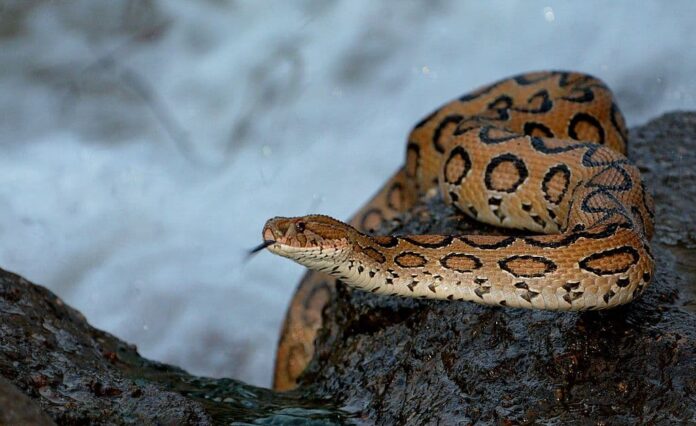Among at least 60 species of venomous snakes, “The Big Four” are the snakes that cause the most human deaths. Each of them is not only deadly but also responsible for the majority of snakebite incidents in the country. There are at least 250,000 snake bites in India per year, and between 15% to 20% of the victims die. From ambush predators to silent killers, the Big Four has them all. You will find 4 deadliest venomous snakes in the list below, and you probably know all of them so take a look.
1Common Krait
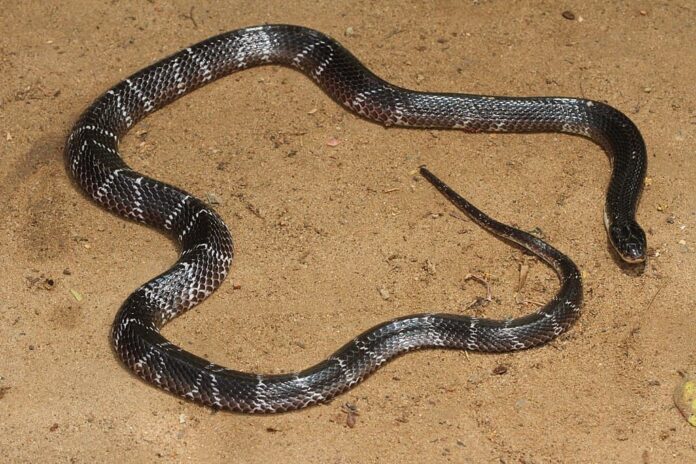
The common krait or blue krait is a venomous snake species with a thin and round body. Their colors range from black and blue to brown and gray, with white stripes on the lower body part. Common kraits are distributed throughout South India and Sri Lanka in a variety of habitats in the Indian subcontinent. From paddy fields to inhabited areas and inside the house, common kraits are pretty much everywhere. Mostly, they rest in brick piles, rat holes, termite mounds, and places near a water source. Because of their wide range, their encounter with humans is also very common as well.
These venomous snakes are solitary, and they are active both during the day and night time. The thing is that common kraits are more docile and sluggish during the day. When resting, they often roll their body into a loose coiled ball while keeping their head well concealed. In this condition, common kraits actually allow considerable handling but they might bite if you overhandle them. Blue kraits are more aggressive at night because they are more active at this time. These slender snakes are reluctant to bite, but they will hold on for a while when they do. This also means they are able to inject a large amount of venom.
Venom: The venom of common kraits consists mostly of powerful neurotoxin that induces muscle paralysis. Those neurotoxins generally affect the nerve endings near the synaptic clef of the brain. Although almost painless, the bites can cause abdominal cramps followed by a progressive paralysis. In fact, their venom is considered to be 15 times more toxic than that of the Indian cobra. The mortality rate is high even with antivenin treatment which is why they are among the big four.
2Indian Cobra
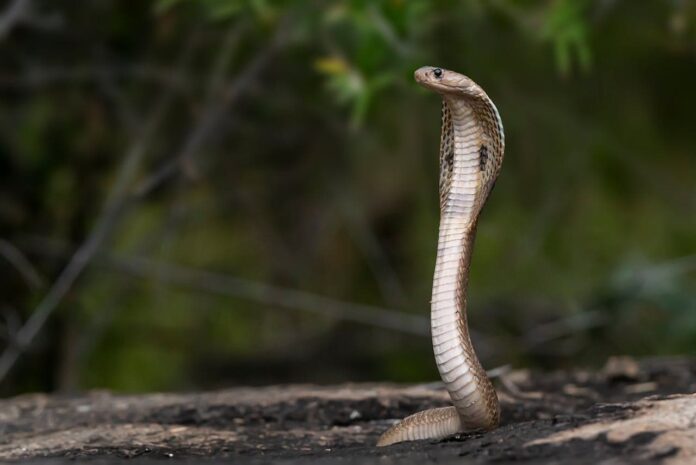
Also known as the spectacled cobra, the Indian cobra has 2 circular ocelli patterns connected by a curved line on their hood. This is also the longest venomous snake with a long round body with different colors varying from black to brown. Indian cobras are native to the Indian subcontinent, and they prefer forests, grasslands, open forests, plains, rice paddies, wetlands, etc. When not hunting, these cobras reside in their holes in embankments, rock piles, small dens, termite mounds, or tree hollows. Because of human civilization, people expand their homes close to the habitats of these cobras. This is why Indian cobra encounters become more and more common, and so are the bites.
Despite being one of the most venomous snakes, Indian cobras are very popular among snake charmers. This is because of their dramatic threat posture and the beautiful spectacles as the snakes sway to the tune of the charmer’s flute. Indian cobras are active at night, and they are capable of climbing and swimming when it comes to hunting. They are not aggressive, but they will bite if they have to. The Indian cobra is among the big four snakes that are responsible for the majority of human deaths by snakebites in Asia. However, their population is threatened due to illegal hunting for their distinctive hood markings for leather goods production.
Venom: An Indian cobra’s venom mainly contains a powerful cardiotoxin and post-synaptic neurotoxin that act on the synaptic gaps of the nerves. The primary symptoms include abdominal pain, anticoagulation, breathing difficulty, necrosis, and vomiting. This leads to muscle paralysis, and severe bites can cause cardiac arrest and respiratory failure. The envenomation symptoms usually manifest between 15 minutes to 2 hours following the bite. Without treatment, the potent venom from their bites can be fatal.
3Russell’s Viper
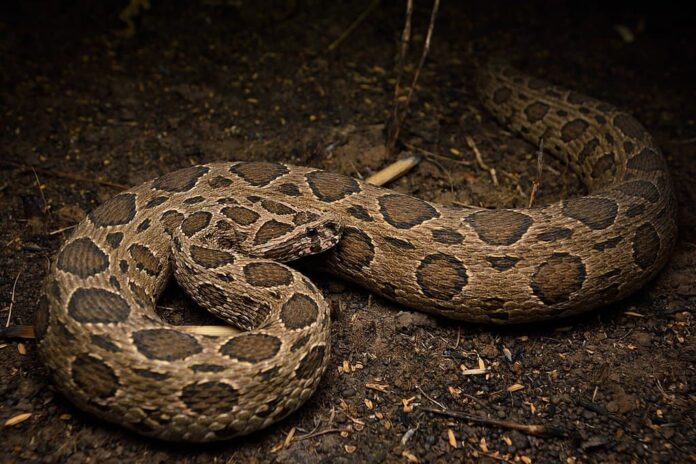
This is a venomous viper species that is also known as chain viper or daboia. There are two subspecies of Russell’s viper that live in China, India, Southeast Asia, and Taiwan. However, these venomous snakes are among the big four that kill a lot of people in India. You can find them in rural and urban areas where rodents are plenty for them to feed on. Russell’s vipers have a flattened triangular head with a blunt snout, large nostrils, and two long fangs. Their body colors range from beige and brown to deep yellow with almond-shaped spots surrounded by black rings. Chain vipers live in agricultural fields, forests, grasslands, pains, and scrublands.
Russell’s vipers are nocturnal so they hunt at night, and they like to bask in the sun during the day. However, these venomous snakes will be active during the day in cool periods of the year. Although they help to get rid of mice, Russell’s vipers induce more snakebites than any other types of venomous snakes. These loyal members of the big four are terrestrial, and they usually move slowly and sluggishly but they become very aggressive when threatened. Before the attack, they will coil the body in numerous S-shaped loops, elevate the upper third of the body, and hiss loudly. With this position, they can exert so much force they lift most of the body when striking. The bite can be a snap or they may hang on for many seconds to inject the venom.
Venom: Russell’s vipers have very strong venom that can cause strong bleeding along with neck muscle paralysis. In severe cases, the venom can lead to permanent renal damage and death without immediate treatment.
4Saw-Scaled Viper
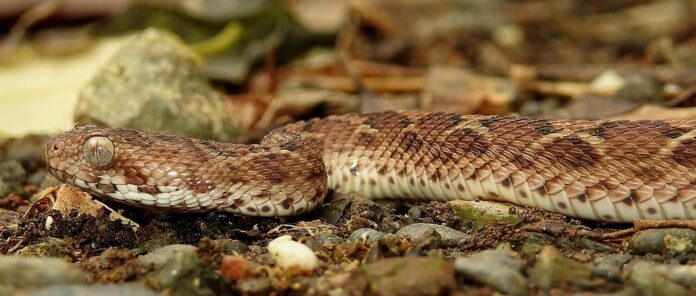
Little but deadly, saw-scaled viper is the smallest member of the big four. Don’t let the size make you think otherwise because these snakes also cause many human deaths from snakebites annually. You can recognize them but their flat and wide head, narrow neck along with the cylindrical stout body. Saw-scaled vipers live in deserts, dry plains, and rocky slopes of India, Sri Lanka, and West Africa. Just like some small people, these small venomous snakes also have aggressive temperaments and fast striking speeds. And when they strike, they strike to bite and they hardly miss. Plus with the strong bite and toxic venom, Russell’s vipers are the snakes to watch out for.
Besides being venomous, these enigmatic snakes of the big four also have interesting sidewinding movements. This allows people to identify their tracks to avoid the encounter because making them angry is a bad choice. In defensive mode, the viper will coil its body into broad loops behind its head. Then it will rub the loops against each other, making a loud rasping noise with its serrated scales. While remaining coiled, the snake will throw its head forward and strike repeatedly. Rumor has it that saw-scaled vipers also chase or rust toward people and strike at their ankles. It is true that they don’t cause many fatalities, but their bites can cause a lot of tissue damage. Even worse, permanent loss of limbs if not treated promptly and well.
Venom: Within minutes of bites, the symptoms are localized swelling and pain. Those followed slowly by coagulation and hemorrhage which may lead to hypovolemic shock. If things get serious, the most dangerous symptoms are blood-clotting trouble and internal bleeding which can lead to kidney failure. The mortality rate from their venom is actually about 20% because o the availability of antivenom. As long as the victims seek treatment on time, the chance of death is not so high.
Related Post: Most Dangerous Snakes In Asia

